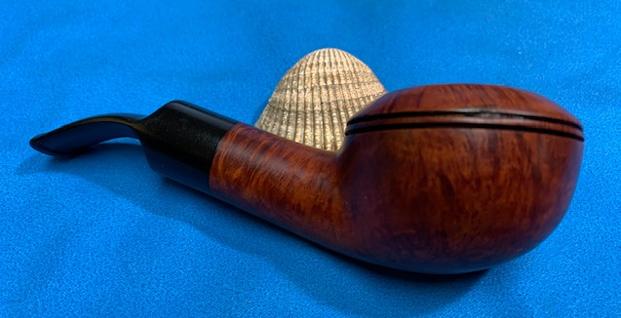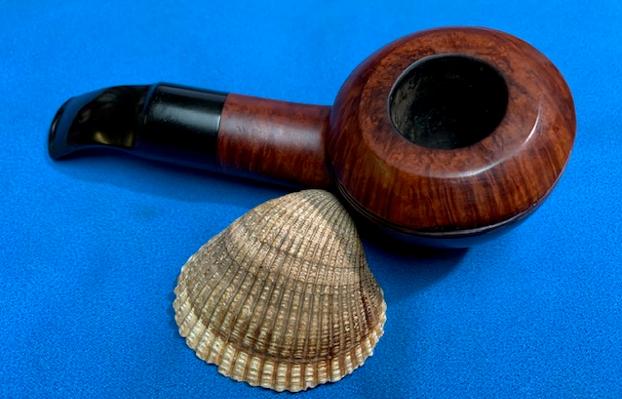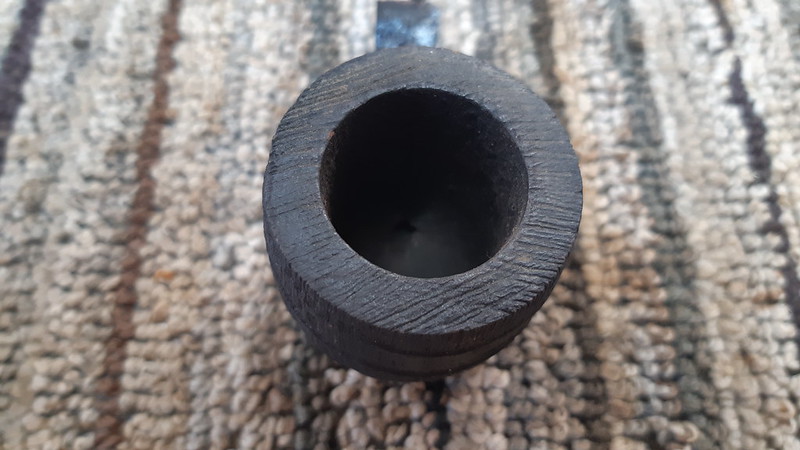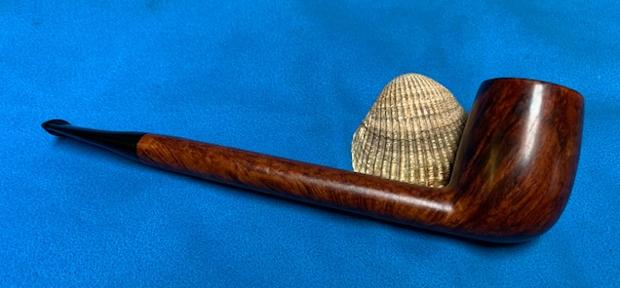Blog by Steve Laug
 It was not that long ago that I was contacted by an older gentleman about purchasing his pipe collection. He sent me the photos and I was amazed at what I saw. He had Dunhill pipes, BBB pipes, Orlik pipes, Barclay Rex Pipes, a couple of Meerschaums and a whole lot of other pipes. All I could say as I looked at the pipes was what a collection it was. We negotiated a deal and I think we both walked away quite happy with the exchange.
It was not that long ago that I was contacted by an older gentleman about purchasing his pipe collection. He sent me the photos and I was amazed at what I saw. He had Dunhill pipes, BBB pipes, Orlik pipes, Barclay Rex Pipes, a couple of Meerschaums and a whole lot of other pipes. All I could say as I looked at the pipes was what a collection it was. We negotiated a deal and I think we both walked away quite happy with the exchange.
You have seen the work we have done on the Dunhills, Hardcastles, H. Simmons all briar billiard and BBB pipes from the lot but there are still more. The above photo shows what I thought were all of the Barclay-Rex pipes that he had purchased from the New York City Shop. Since getting them I have found several more in the assorted pipes that he included. Turns out there are actually 8 Barclay-Rex pipes. The pipe I am working on is the second pipe in from the top left of the picture and is a Rhodesian with a twin ring around the bowl and a capped rim top. I have circled it in red in the photo above.
I have worked on several Barclay-Rex pipes in the past and this large bowled Rhodesian is a special one with a lot of issues around the rim cap and rings. It really is a beauty in terms of shape and grain. This pipe is stamped on the left side of the shank and reads BARCLAY-REX [over] New York. The stamping is clear and readable and there is no shape number evident.
Jeff took some photos of the BARCLAY-REX Large Rhodesian with a slightly bent stem before he worked his magic in cleaning up the pipe. It is a an interesting pipe with a lot of potential and what appears to be some great grain under the grime and debris of the years. Jeff took photos of the bowl, rim top to show the thickness of the cake in the bowl and the thick lava on the rim top. It is hard to know the condition of the rim edges and top with the thick cake and lava in place. He took photos of the top and underside of the vulcanite stem showing the oxidation, calcification, tooth marks, chatter and wear on the stem and button.
Jeff took photos of the bowl, rim top to show the thickness of the cake in the bowl and the thick lava on the rim top. It is hard to know the condition of the rim edges and top with the thick cake and lava in place. He took photos of the top and underside of the vulcanite stem showing the oxidation, calcification, tooth marks, chatter and wear on the stem and button.

 Jeff took photos of the sides and heel of the bowl to show the condition of the briar. You can see the beautiful shape and the grain on the bowl even through the dirt and debris of many years.
Jeff took photos of the sides and heel of the bowl to show the condition of the briar. You can see the beautiful shape and the grain on the bowl even through the dirt and debris of many years.
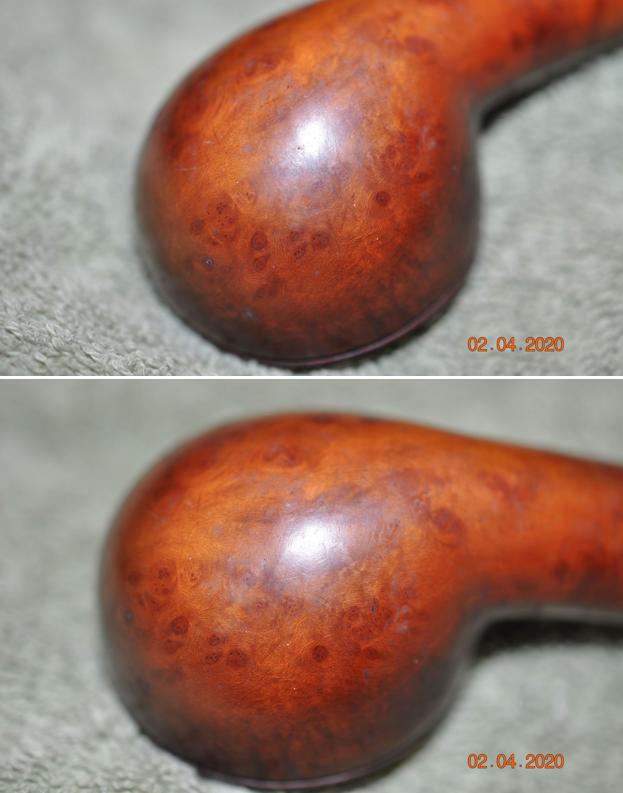 Jeff took a photo of the stamping on the left side of the shank. You can see that it is clear and very readable as noted above.
Jeff took a photo of the stamping on the left side of the shank. You can see that it is clear and very readable as noted above. I turned to Pipephil’s site to see what I could learn about the Barclay-Rex brand and particularly the sandblast one I was working on (http://pipephil.eu/logos/en/logo-b1.html). I have included a screen capture of the information that is shown there.
I turned to Pipephil’s site to see what I could learn about the Barclay-Rex brand and particularly the sandblast one I was working on (http://pipephil.eu/logos/en/logo-b1.html). I have included a screen capture of the information that is shown there.  I quote from the sidebar on the site below as it gives a good summary of information.
I quote from the sidebar on the site below as it gives a good summary of information.
Brand created in 1910. The shop was situated on Maiden Lane. Three addresses now (2010): 75 Broad Street, 70 East 42nd Street, 570 Lexington Avenue. See also: André
I turned to Pipedia to try and place this pipe in the timeline of the brand and was able find some helpful information which I have included below (https://pipedia.org/wiki/Barclay_Rex). I quote the information below.
Barclay-Rex, a downtown Manhattan tobacconist, was founded in 1910 by Vincent Nastri, a pipemaker from Salerno, Italy. The store was originally located at Barclay and Church Street, and the name was taken from that location and Nastri’s beloved Great Dane, Rex. The business is still run by Vincent Nastri, III and owned by Vincent Nastri, Jr.. They have several locations in New York City. The store has carried pipes from all fine makers, and the Barclay-Rex line of pipes is also much sought after, in that pipes were made in a range from the very inexpensive into the several hundreds of dollars. The pipes were, at least into the 1960’s, made of Algerian briar.
In addition to pipes made by Mr. Nastri over the years, Mr. Nastri, III, has been quoted as stating that a pipemaker just leaving Dunhill made pipes with a small off-white dot on the stem for a time for the shop. As was discovered by Steve Laug of Reborn Pipes, they were evidently made by a pipemaker whose initials were HGP, and stamped on the pipe as such. These pipes were made for a single run only, and then never made again.
In addition, Sasieni at least for a time made private label pipes stamped with the Barclay-Rex name, but with their own shapes and shape numbers.
Locations: (Flagship Store) 75 Broad Street, New York, New York 10004 Telephone: (212) 962-3355
70 East 42nd Street, New York, New York 10165 Telephone: (212) 692-9680
570 Lexington Avenue, New York, New York 10022 Telephone: (212) 888-1015
Email: info@barclayrex.com Website: http://www.barclayrex.com Toll Free: (888) 278-6222 Fax: (212) 962-3372
With the information from Pipedia I knew that I was working on a pipe from the Barclay-Rex Tobacconist in New York City. The fellow we bought them from intimated that he purchased them at the Manhattan store. I was unable to pin down any information regarding the date this pipe was made. Now it was time to work on the pipe.
Jeff carefully cleaned the pipe. He reamed it with a PipNet pipe reamer and then cleaned up the reaming with a Savinelli Fitsall Pipe Knife. He scrubbed out the internals of the shank, stem and shank extension with alcohol, pipe cleaners and cotton swabs until the pipe was clean. He scrubbed the exterior of the bowl with Murphy’s Oil Soap and a tooth brush to remove the grime and grit on the briar and lava on the rim top. The finish looks much better and has a deep richness in the colour that highlights grain of the briar. The rim top looked good with some darkening on the top and light damage to the inner edge of the bowl. When the pipe arrived here in Vancouver I was amazed it looked so good. Here are some photos of what I saw. (I had already started working on the damage to the cap when I remembered to take these photos…. Sorry about that. 
 I took some close up photos of the rim top and the stem surface. The inner edge of the rim had some nicks and darkening. There was some darkening on the rim top that would need to be cleaned up. I took close up photos of the stem to show the condition of the surface and button.
I took some close up photos of the rim top and the stem surface. The inner edge of the rim had some nicks and darkening. There was some darkening on the rim top that would need to be cleaned up. I took close up photos of the stem to show the condition of the surface and button.  I took a picture of the stamping on the left side of the shank and it was faint but readable as noted above.
I took a picture of the stamping on the left side of the shank and it was faint but readable as noted above.  I removed the stem from the shank and took a photo of the parts of the pipe.
I removed the stem from the shank and took a photo of the parts of the pipe.  I started my work on the pipe by addressing the damage to the lower edge of the bowl cap above the top ring. There were large chips of briar that had broken off the bowl and needed to be repaired.
I started my work on the pipe by addressing the damage to the lower edge of the bowl cap above the top ring. There were large chips of briar that had broken off the bowl and needed to be repaired. 
 I am experimenting with a new method for repairing these chips. I cut an old gift card (ignore the bar code it is useless) to fit the curve of the bowl. I greased the edge with Vaseline so that the CA glue and briar dust would not stick to it. I dripped CA glue into the damaged areas and then pressed briar dust into the glue with a dental spatula. I repeated the process until the repair was sufficient. Once it had hardened, I removed the card and touched up the repair with CA glue.
I am experimenting with a new method for repairing these chips. I cut an old gift card (ignore the bar code it is useless) to fit the curve of the bowl. I greased the edge with Vaseline so that the CA glue and briar dust would not stick to it. I dripped CA glue into the damaged areas and then pressed briar dust into the glue with a dental spatula. I repeated the process until the repair was sufficient. Once it had hardened, I removed the card and touched up the repair with CA glue.
 I sanded the repaired areas with 220 grit sandpaper to smooth them out. I used a flat blade needle file to clean up the two rings around the bowl. This is tedious and time consuming but with work it will pay off and look better.
I sanded the repaired areas with 220 grit sandpaper to smooth them out. I used a flat blade needle file to clean up the two rings around the bowl. This is tedious and time consuming but with work it will pay off and look better.

 I stained the repaired areas with a Cherry Stain Pen to blend it into the surrounding areas of the bowl and rim cap.
I stained the repaired areas with a Cherry Stain Pen to blend it into the surrounding areas of the bowl and rim cap.
 I worked on the darkening on the rim top and the damage on the edges of the bowl next. I used a folded piece of 220 grit sandpaper to work over the inner and outer edge to smooth out the damage and to remove the darkening on the rim top as well.
I worked on the darkening on the rim top and the damage on the edges of the bowl next. I used a folded piece of 220 grit sandpaper to work over the inner and outer edge to smooth out the damage and to remove the darkening on the rim top as well. I polished the briar with micromesh sanding pads – dry sanding with 1500-12000 grit pads. I wiped the briar down with a damp cloth after each pad.
I polished the briar with micromesh sanding pads – dry sanding with 1500-12000 grit pads. I wiped the briar down with a damp cloth after each pad.




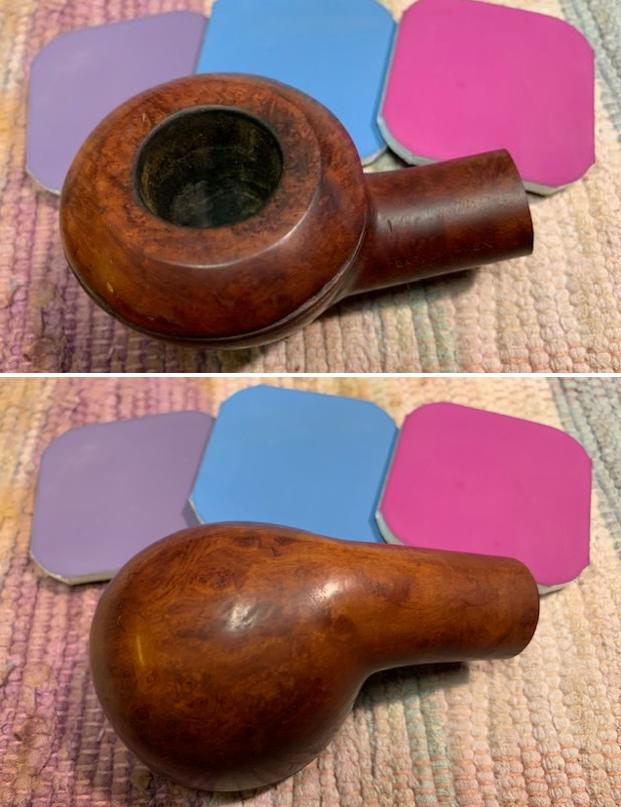 I worked some Before & After Restoration Balm into the surface of the bowl and shank with my fingertips to clean, enliven and protect the briar. I let the balm sit for 15 minutes and then buffed with a cotton cloth to raise the shine. The photos show the bowl at this point in the restoration process.
I worked some Before & After Restoration Balm into the surface of the bowl and shank with my fingertips to clean, enliven and protect the briar. I let the balm sit for 15 minutes and then buffed with a cotton cloth to raise the shine. The photos show the bowl at this point in the restoration process.

 I set the bowl aside and turned my attention to the stem. I “painted” it with the flame of a Bic lighter to lift the tooth dents in the surface of the vulcanite. I was able to lift all of them on the underside and sandpaper would smooth out the remainder. There was one remaining tooth mark on the top side along the face of the button. I filled in the remaining mark with clear CA glue. Once the repairs cured I sanded them smooth with a folded piece of 220 grit sandpaper to blend them in the rest of the stem surface. I started polishing the stem with 400 grit wet dry sandpaper.
I set the bowl aside and turned my attention to the stem. I “painted” it with the flame of a Bic lighter to lift the tooth dents in the surface of the vulcanite. I was able to lift all of them on the underside and sandpaper would smooth out the remainder. There was one remaining tooth mark on the top side along the face of the button. I filled in the remaining mark with clear CA glue. Once the repairs cured I sanded them smooth with a folded piece of 220 grit sandpaper to blend them in the rest of the stem surface. I started polishing the stem with 400 grit wet dry sandpaper. 

 I polished the stem with micromesh sanding pads – dry sanding with 1500-12000 grit sanding pads. I wiped it down after each sanding pad with Obsidian Oil. I polished it with Before & After Pipe Stem Polish – both Fine and Extra Fine. I gave it a final coat of Obsidian Oil.
I polished the stem with micromesh sanding pads – dry sanding with 1500-12000 grit sanding pads. I wiped it down after each sanding pad with Obsidian Oil. I polished it with Before & After Pipe Stem Polish – both Fine and Extra Fine. I gave it a final coat of Obsidian Oil.
 With the bowl and the stem finished I put the beautiful Barclay-Rex New York Large Rhodesian back together and buffed it on the wheel using Blue Diamond to give it a shine. I gave the bowl and the stem multiple coats of carnauba wax on the wheel. I buffed it with a clean buffing pad to raise the shine. I hand buffed it with a microfiber cloth to deepen the shine. It really is a great looking sandblast. The dimensions of the pipe are – Length: 5 ½ inches, Height: 1 ½ inches, Outside diameter of the bowl: 2 inches, Chamber diameter: 7/8 of an inch. The weight of this large pipe is 2.65 ounces /75 grams. This Barclay-Rex Large Rhodesian is another great find in this collection. It is much more beautiful in person than these photos can capture. I will be putting it on the rebornpipes store soon. If you would like to add it to your collection let me know. This is another pipe that has the possibility of transporting the pipe man or woman back to a slower paced time in history where you can enjoy a respite. Thanks for walking through the restoration with me.
With the bowl and the stem finished I put the beautiful Barclay-Rex New York Large Rhodesian back together and buffed it on the wheel using Blue Diamond to give it a shine. I gave the bowl and the stem multiple coats of carnauba wax on the wheel. I buffed it with a clean buffing pad to raise the shine. I hand buffed it with a microfiber cloth to deepen the shine. It really is a great looking sandblast. The dimensions of the pipe are – Length: 5 ½ inches, Height: 1 ½ inches, Outside diameter of the bowl: 2 inches, Chamber diameter: 7/8 of an inch. The weight of this large pipe is 2.65 ounces /75 grams. This Barclay-Rex Large Rhodesian is another great find in this collection. It is much more beautiful in person than these photos can capture. I will be putting it on the rebornpipes store soon. If you would like to add it to your collection let me know. This is another pipe that has the possibility of transporting the pipe man or woman back to a slower paced time in history where you can enjoy a respite. Thanks for walking through the restoration with me.
